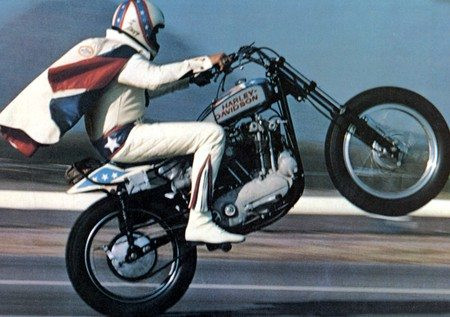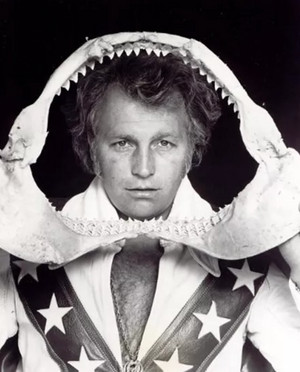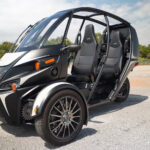Evel Knievel, the name synonymous with death-defying motorcycle stunts, captivated the world. But beyond the jumps and crashes, the roar of the engine and the glint of chrome were integral to his persona. For Evel Knievel, the bike was more than just a machine; it was an extension of himself, a partner in his audacious ballet with gravity. This is the story of Evel Knievel and his bikes, the iconic machines that propelled him into legend.
Robert Craig Knievel, born in Butte, Montana, in 1938, didn’t start his professional stunt career until his late twenties. However, his love affair with motorcycles began much earlier. Like many, his first taste of two-wheeled freedom came at a young age, albeit in a less than legal manner.
 Evel Knievel as a child, a black and white portrait, implying his early life and humble beginnings.
Evel Knievel as a child, a black and white portrait, implying his early life and humble beginnings.
Knievel’s youthful energy wasn’t always channeled constructively. His first motorcycle, a Harley-Davidson, was reportedly stolen at the age of 13. While this anecdote might be embellished, it speaks to his early fascination with these powerful machines. By 16, his grandmother, perhaps sensing a need to guide his passion, bought him a Triumph. This marked a turning point, shifting his relationship with bikes from delinquency to a more personal, albeit still rebellious, pursuit.
 Young Evel Knievel posing with a Triumph motorcycle, highlighting his early affinity for Triumph bikes and motorcycles in general.
Young Evel Knievel posing with a Triumph motorcycle, highlighting his early affinity for Triumph bikes and motorcycles in general.
The moniker “Evel Knievel” itself has an interesting origin, stemming from a reckless riding arrest and a comparison to “Awful Knofel.” The name stuck, and Robert legally changed it, refining “Evil” to “Evel,” feeling it had a better ring. This rebranding was characteristic of Knievel’s understanding of showmanship and image, crucial elements in building his daredevil empire.
 Evel Knievel with his grandmother, showcasing a personal side of the daredevil and hinting at the support system behind his risky career.
Evel Knievel with his grandmother, showcasing a personal side of the daredevil and hinting at the support system behind his risky career.
Before fame, Knievel’s life was a tapestry of varied experiences, from military service as a paratrooper to semi-professional hockey. He even dabbled in motorcycle racing, experiencing the harsh realities of crashes and injuries early in his riding career in 1962. These experiences, both the triumphs and setbacks, shaped him into the resilient and determined figure the world would come to know.
From Local Jumps to National Fame: The Honda and the Triumph
Knievel’s transition to professional stunting began in 1965. To promote his motorcycle shop, he staged his first public jump over cars and rattlesnakes on a Honda 350cc. While the landing wasn’t perfect – he landed on the rattlesnakes – the spectacle drew a crowd and ignited his ambition. He realized the public’s appetite for daring feats.
 Evel Knievel performing an early jump, possibly on a Honda, emphasizing the beginning of his stunt career and his initial choice of motorcycle brands.
Evel Knievel performing an early jump, possibly on a Honda, emphasizing the beginning of his stunt career and his initial choice of motorcycle brands.
Following this initial success, Evel formed “Evel Knievel’s Motorcycle Daredevils,” touring the Western states. During this period, he often rode Triumph motorcycles, including the Triumph Bonneville. These bikes were reliable and offered the performance needed for his growing stunts, though crashes were frequent and bone-breakingly common.
 Evel Knievel jumping a line of cars on a Triumph motorcycle, demonstrating his Triumph era and the increasing scale of his stunts.
Evel Knievel jumping a line of cars on a Triumph motorcycle, demonstrating his Triumph era and the increasing scale of his stunts.
The Harley-Davidson XR-750: The Ultimate Evel Knievel Bike
While Knievel experimented with Honda, Norton, and Triumph, it was the Harley-Davidson XR-750 that became his signature bike. For a figure who embodied American bravado, Harley-Davidson, an iconic American brand, was a natural fit.
 Evel Knievel posing proudly with his Harley-Davidson XR-750, highlighting the iconic motorcycle that became synonymous with his image.
Evel Knievel posing proudly with his Harley-Davidson XR-750, highlighting the iconic motorcycle that became synonymous with his image.
The XR-750 was originally designed for dirt track racing, but its robust build and powerful 748cc V-twin engine, producing 70-100 horsepower, made it adaptable for paved track stunts. Its lightweight yet sturdy frame (147 kg dry) provided the agility and resilience Knievel needed. He often remarked on the XR’s immense torque, which, while powerful, made controlling it after takeoff a challenge, as visually captured in many of his jump photos.
 Close up view of a Harley-Davidson XR-750, showcasing the details of the bike Evel Knievel preferred for his stunts.
Close up view of a Harley-Davidson XR-750, showcasing the details of the bike Evel Knievel preferred for his stunts.
Caesars Palace and the Triumph Bonneville Crash
The infamous Caesars Palace fountain jump in 1967 is a stark reminder of the risks Knievel undertook. Interestingly, for this particular stunt, he chose a Triumph Bonneville, not his later favored Harley-Davidson. While the jump itself was successful, the landing was catastrophic.
 Evel Knievel crashing his Triumph Bonneville at Caesars Palace, emphasizing the dangers of his stunts and the dramatic nature of his career.
Evel Knievel crashing his Triumph Bonneville at Caesars Palace, emphasizing the dangers of his stunts and the dramatic nature of his career.
“It was terrible,” Knievel recounted. “I lost control of the bike. Everything seemed to come apart… I kept smashing over and over and ended up against a brick wall.” The crash resulted in severe injuries, including a fractured skull and broken pelvis, hips, and ribs, leaving him unconscious for a month.
 Evel Knievel falling from his Triumph Bonneville at Caesars Palace, a dramatic image capturing the moment of impact during his most famous crash.
Evel Knievel falling from his Triumph Bonneville at Caesars Palace, a dramatic image capturing the moment of impact during his most famous crash.
Despite the near-fatal outcome, the Caesars Palace jump catapulted Knievel to international fame. He shrewdly filmed the stunt himself, later selling the footage for millions, proving his business acumen was as sharp as his daredevil spirit. His first purchase after recovery? A Rolls Royce, a symbol of his burgeoning success and flamboyant personality.
 Evel Knievel's Rolls Royce parked at his house, symbolizing his success and flamboyant lifestyle after achieving fame.
Evel Knievel's Rolls Royce parked at his house, symbolizing his success and flamboyant lifestyle after achieving fame.
Snake River Canyon and the Rocket Bike: The Skycycle X2
Always pushing boundaries, Knievel conceived his most audacious stunt yet: jumping the Snake River Canyon in 1974. For this unprecedented feat, no motorcycle, not even the powerful XR-750, would suffice. He needed a rocket.
 Evel Knievel and his son Robert inspecting the Skycycle X2 rocket bike, highlighting the extreme measures taken for his Snake River Canyon jump.
Evel Knievel and his son Robert inspecting the Skycycle X2 rocket bike, highlighting the extreme measures taken for his Snake River Canyon jump.
He commissioned the Skycycle X2, a rocket-powered machine built by aeronautical and US Navy engineers. This wasn’t a motorcycle in the traditional sense, but a purpose-built rocket bike designed to traverse the vast canyon. The Skycycle X2 was launched from a 108-foot ramp, reaching speeds of 350 mph.
 The Skycycle X2 launching off the ramp over Snake River Canyon, illustrating the scale and ambition of this rocket jump attempt.
The Skycycle X2 launching off the ramp over Snake River Canyon, illustrating the scale and ambition of this rocket jump attempt.
On September 8, 1974, in front of thousands, Knievel launched the Skycycle X2. While the rocket soared across the canyon, the premature deployment of the parachute caused it to descend into the canyon floor, rather than landing on the other side. Despite failing to clear the canyon, the spectacle was a global event, broadcast in movie theaters and on television.
 Evel Knievel in the Skycycle X2 just after launch, wearing a distinctive helmet, showcasing the unique and somewhat unconventional safety gear for this rocket stunt.
Evel Knievel in the Skycycle X2 just after launch, wearing a distinctive helmet, showcasing the unique and somewhat unconventional safety gear for this rocket stunt.
 The Skycycle X2 floating down into Snake River Canyon after the parachute deployed, showing the outcome of the jump and the safe landing of the rocket bike.
The Skycycle X2 floating down into Snake River Canyon after the parachute deployed, showing the outcome of the jump and the safe landing of the rocket bike.
Wembley and Retirement (Sort Of)
Back on his Harley-Davidson XR-750, Knievel continued to perform, becoming a global phenomenon. In 1975, he attempted to jump 13 buses at Wembley Stadium in London. A specially constructed ramp, extending over the stadium stands, was built to provide the necessary run-up.
 Evel Knievel jumping buses at Wembley Stadium, London, demonstrating his international appeal and large-scale stunts.
Evel Knievel jumping buses at Wembley Stadium, London, demonstrating his international appeal and large-scale stunts.
However, Wembley followed the pattern of many Knievel stunts – a dramatic crash. He broke his pelvis, vertebrae, and hand. Despite the severe injuries, Knievel, in true showman fashion, announced his retirement from stunting at Wembley, famously walking off the field.
 Evel Knievel crashing at Wembley Stadium, highlighting another significant crash and his seemingly unbreakable spirit.
Evel Knievel crashing at Wembley Stadium, highlighting another significant crash and his seemingly unbreakable spirit.
Yet, retirement for Evel was a loose term. Later in 1975, he successfully jumped 14 Greyhound buses at Kings Island, Ohio, setting a record that stood for 24 years. He announced retirement again after this successful jump, but the lure of the spectacle was strong.
The Shark Jump and Final Retirement
In 1977, Knievel planned another sensational stunt: jumping a tank filled with sharks. This time, on his Harley-Davidson. However, during rehearsal, he crashed, injuring himself and a cameraman. The accident, particularly the injury to the cameraman, deeply affected Knievel and marked a true turning point.
 A cartoonish image of a shark tank jump, likely representing Evel Knievel's planned shark jump stunt.
A cartoonish image of a shark tank jump, likely representing Evel Knievel's planned shark jump stunt.
The shark jump incident became the catalyst for Knievel’s final retirement from major stunts. He transitioned to speaking engagements, acknowledging he had pushed his luck far enough. His son, Robbie Knievel, followed in his footsteps, continuing the daredevil legacy.
 Robbie Knievel visiting Jay Leno, showing the continuation of the Knievel stunt legacy through his son.
Robbie Knievel visiting Jay Leno, showing the continuation of the Knievel stunt legacy through his son.
Legacy of a Daredevil and His Bikes
Evel Knievel’s career was a testament to his audacious spirit and showmanship. His choice of bikes, particularly the Harley-Davidson XR-750, became integral to his image. These machines weren’t just tools; they were partners in his daring performances, symbols of American power and freedom.
 Evel Knievel on his Harley-Davidson XR-750, an iconic image embodying his daredevil persona and the powerful motorcycle he rode.
Evel Knievel on his Harley-Davidson XR-750, an iconic image embodying his daredevil persona and the powerful motorcycle he rode.
Despite the numerous crashes and injuries that plagued his career, Evel Knievel became a pop culture icon, inspiring generations with his “live fast, die young” attitude and his unwavering belief in pushing limits. He was inducted into the Motorcycle Hall of Fame in 1999, solidifying his place in motorcycle history. Evel Knievel’s bikes, especially his Harley-Davidson XR-750, remain enduring symbols of his daredevil legacy.
 Evel Knievel performing a wheelie on his Harley-Davidson, showcasing his bike handling skills and the dynamic relationship he had with his motorcycles.
Evel Knievel performing a wheelie on his Harley-Davidson, showcasing his bike handling skills and the dynamic relationship he had with his motorcycles.
 Evel Knievel performing a jump on his Harley-Davidson, capturing the essence of his daredevil stunts and the powerful machines that enabled them.
Evel Knievel performing a jump on his Harley-Davidson, capturing the essence of his daredevil stunts and the powerful machines that enabled them.

